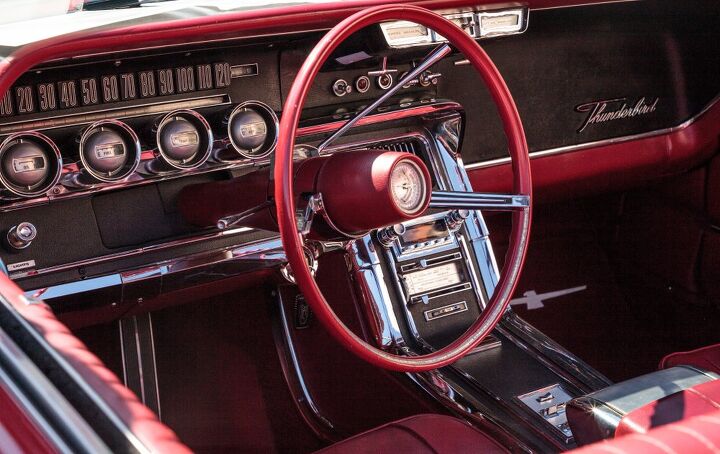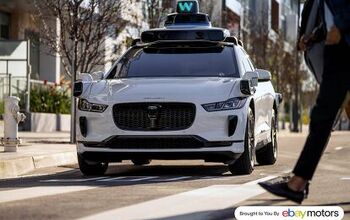Analog Revenge: Chip Shortage Forcing Automakers to Ditch Tech

After months of seeing factories idled, it seems that the global semiconductor shortage has encouraged the automotive sector to rethink some production strategies. Numerous brands have opted to strip vehicles of specific features to help offset the ever-worsening chip problem, occasionally supplanting them with older hardware.
Well, well, well. It looks like the push into electromobility hasn’t gone quite as planned and the industry has come crawling back to analog in some cases. Though it would be premature to break out the campaign and declare the old ways superior for all time. The resurgence of analog hardware is likely to be short-lived, ending the second the semiconductor shortage lets up. As much as your author wants to believe the industry will learn a lesson about not putting all your eggs in one basket, it didn’t seem to in the last century and is unlikely to come around during this one.
While we knew automakers had begun cutting corners and thinking outside the box to address the chip shortage, reporting from Bloomberg opened our eyes to some of what’s happening in markets outside of our own. Many automakers are now stripping high-end features from cars where customers wouldn’t normally expect them so they can be reallocated for premium or high-volume models. For example, the Peugeot 308 going back to analog gauges and Renault’s Arkana is settling for a smaller central display without navigation.
In fact, neutering GPS has been a common solution for manufacturers encountering a chip deficit. Nissan has also cut navigation as standard equipment from some products so they could be used more popular models and we’ve heard rumors that other manufacturers are following suit. But it’s not just the flashy stuff. General Motors announced it will build certain 2021 light-duty full-size pickup trucks without a fuel management module, worsening fuel efficiency by around a mile per gallon.
There have also been cutbacks on some driving aids, though not the outright massacre some of us had been hoping for. Ram 1500s no longer offer blind-spot monitoring and nixed its digital rearview mirror, customers now have to order them special. It’s something we’re expecting from other manufacturers, especially since it provides them an opportunity to charge extra for something that used to be standard content. We’re hoping the same happens to those wildly invasive connectivity features and half-baked (often counterproductive) advanced driving aids, but nobody is holding their breath.
Still, the semiconductor shortage is only going to get worse. What was previously dubbed a short-term problem has evolved into a harrowing industrial nightmare caused largely by our own stupidity. Had the industry decided to gradually ramp up automotive technology (perhaps after features had been more thoroughly tested), decided that pandemic-related lockdowns didn’t need to be quite so strict, or bothered to rely on something other than global just-in-time supply chains, the situation would be far less dire.
From Bloomberg:
A failure to secure critical supplies is a massive short-term setback — millions of vehicle sales will be lost this year — and is a bad sign for the future as competition from tech-savvy internet and consumer-electronics companies intensifies.
“This probably gets worse before it gets better,” said Stacy Rasgon, who covers the semiconductor industry for Sanford C. Bernstein. “It just takes a long time to bring this capacity online.”
NXP Semiconductor CEO Kurt Sievers said the shift to EVs is happening faster than anticipated, which has added to the increased demand for automotive chips. NXP plans to ship at least 20 percent more auto chips by revenue in the first half of 2021 compared with the first half of 2019, even though car production has dropped about 10 percent over the period, he said.
Mark Liu, chairman of Taiwan Semiconductor Manufacturing Co., cautioned the crisis is far from over. His company, which is the world’s most advanced chipmaker and will be critical to any resolution, will begin to meet auto clients’ minimum requirements by June, but expects the car-chip shortages could last until early 2022, he said in an interview with CBS.
With electronics accounting for increasingly more of a vehicle’s sale price, your author has envisioned a world where car companies sell cheap, basic automobiles that forego a lot of the distracting bells and whistles that have become commonplace over the last decade. However, that would represent a complete about-face for an industry that’s become totally preoccupied with electrification and connectivity and be at odds with policies advanced by world governments.
The more realistic scenario is extended production lulls and rampant shortages extending beyond semiconductor chips. Auto suppliers are bending over backward to procure components and they’re just one of several industries doing the same. Meanwhile, the turnaround on orders placed continues to balloon with most firms lucky to see their chip deliveries arriving within four months. Current estimates have the shortage costing the automotive sector over three million units of vehicles by year’s end.
[Image: SunflowerMomma/Shutterstock]

A staunch consumer advocate tracking industry trends and regulation. Before joining TTAC, Matt spent a decade working for marketing and research firms based in NYC. Clients included several of the world’s largest automakers, global tire brands, and aftermarket part suppliers. Dissatisfied with the corporate world and resentful of having to wear suits everyday, he pivoted to writing about cars. Since then, that man has become an ardent supporter of the right-to-repair movement, been interviewed on the auto industry by national radio broadcasts, driven more rental cars than anyone ever should, participated in amateur rallying events, and received the requisite minimum training as sanctioned by the SCCA. Handy with a wrench, Matt grew up surrounded by Detroit auto workers and managed to get a pizza delivery job before he was legally eligible. He later found himself driving box trucks through Manhattan, guaranteeing future sympathy for actual truckers. He continues to conduct research pertaining to the automotive sector as an independent contractor and has since moved back to his native Michigan, closer to where the cars are born. A contrarian, Matt claims to prefer understeer — stating that front and all-wheel drive vehicles cater best to his driving style.
More by Matt Posky
Latest Car Reviews
Read moreLatest Product Reviews
Read moreRecent Comments
- Buickman I was called crazy after predicting the sale of GMAC.#canthurtme
- 3-On-The-Tree Another observation during my time as a firefighter EMT was that seatbelts and helmets do save lives and reduce injury. And its always the other person getting hurt.
- 3-On-The-Tree Jeff, Matt Posky, When my bike came out in 1999 it was the fastest production motorcycle in the world, 150 HP 197 top speed, 9.57 quarter mile Hayabusa peregrine falcon etc. This led to controversy and calls for high-speed motorcycles to be banned in order to avoid increasingly fast bikes from driving on public roads. This led to a mutual decision nicknamed the “ gentleman’s agreement” to limit bikes to 186mph, ending the production bike speed contest for all bikes 2000 and upward. Honestly once your over a buck 20 it’s all a blur. Most super cars can do over or close to 200mpg, I know at least on paper my 09 C6 corvette LS3 tops out at 190mph.
- 3-On-The-Tree In my life before the military I was a firefighter EMT and for the majority of the car accidents that we responded to ALCOHOL and drugs was the main factor. All the suggested limitations from everyone above don’t matter if there is a drunken/high fool behind the wheel. Again personal responsibility.
- Wjtinfwb NONE. Vehicle tech is not the issue. What is the issue is we give a drivers license to any moron who can fog a mirror. Then don't even enforce that requirement or the requirement to have auto insurance is you have a car. The only tech I could get behind is to override the lighting controls so that headlights and taillights automatically come on at dusk and in sync with wipers. I see way too many cars after dark without headlights, likely due to the automatic control being overridden and turned to "Off". The current trend of digital or electro-luminescent dashboards exacerbates this as the dash is illuminated, fooling a driver into thinking the headlights are on.

































Comments
Join the conversation
Some of us are just "analog" and enjoy the pleasure of turning dials and pressing buttons to achieve inner peace and driving harmony. That's why I holding on to my 2012 Ford Escape which has: - Dials to control the volume and station selections. It also has some corresponding remote control buttons on the steering wheel, but I ignore these. - A CD player which is as obsolete as a cassette or 8-track player (remember them). However, I gain great joy popping in a CD and listing to Cheap Trick, Kansas, with Patsy Cline for good measure. I have a stack of CD in my study which I rotate thru as the year goes by. Not to make this a political issue, but , "I'll give you my CDs when you pry them from my cold, dead fingers". - Single control A/C. No duel control, no bi-polar features. Just an easy set of buttons with a direct tactical feel on the face of the dash. What more could you ask for! - Blind spot devices called concave mirrors built into each rear view mirror. Want to change lanes, just look!! No vibration of the steering wheel, no flashing lights, no annoying beeping sound. I love it!! - One concession is Blue Tooth which I only use for incoming calls (there's those funny controls on the steering wheel again). I equate this feature to "hearing aids", therefore I have a tendency to speak very loud when I use the feature. It appears the caller(s) appreciate my raised voice for clear, precise communication. - Lacks a rear facing camera. However, I still young enough (60 +) that I do turn my head and actually look after engaging reverse. - A 8 year old Garmin GPS on the dash board. These are becoming a collector's item and several have been logged into the Smithsonian collection. However, can't beat proven technology. I have used it on several driving tours of Europe with the assistance of sims cards specific to each region of Europa! Worked perfectly!!!!! I just dread replacing the Escape.
Automotive Awesomeness Index = • Number of semiconductor chips divided by • Paint thickness in mils By this measure, automobiles are not only better than ever, but improving at an increasing rate. (Had a random parking lot sighting the other day of a not-very-old BMW roundel with *no* paint remaining - of any color. Tsk. [Brand? What's a brand?]) -> Fail-safe Zombie Identification method: Explain the Automotive Awesomeness Index to your favorite car enthusiast. If they nod in approval, you're talking to an Undead. (Take appropriate action.) "Non-Peak Manufacturing" example: https://www.seattletimes.com/business/west-virginia-factory-is-center-stage-in-supply-chain-crisis-as-u-s-economy-seeks-to-rebound-from-covid/ [Son's friend parked a 2005 Highlander at my house this past weekend. I received permission to do some paint correction on the neglected finish (parked-under-trees-at-off-campus-rental-house level neglect - shudder). Ok that's not exactly true - I was given permission to 'wash' it - turned into more. Anyway, automotive finishes were on my mind. The 2005 factory paint cleaned up pretty well in 2021. How well will a middle-of-the-road 2021 factory paint job clean up in 2037? (I have a prediction.)]